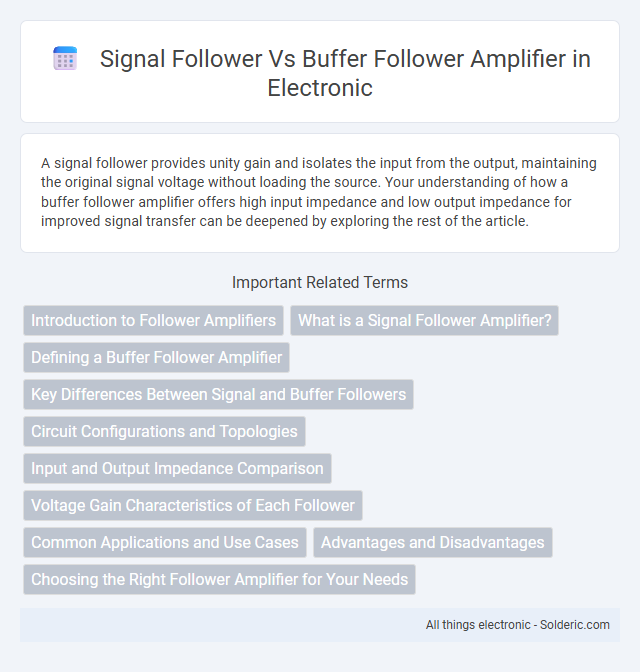A signal follower provides unity gain and isolates the input from the output, maintaining the original signal voltage without loading the source. Your understanding of how a buffer follower amplifier offers high input impedance and low output impedance for improved signal transfer can be deepened by exploring the rest of the article.
Comparison Table
| Feature | Signal Follower | Buffer Follower Amplifier |
|---|---|---|
| Primary Function | Copies input signal without amplification | Isolates and drives loads without signal alteration |
| Voltage Gain | Unity (1) | Unity (1) |
| Input Impedance | High | Very High |
| Output Impedance | Low | Very Low |
| Purpose | Signal replication without loading | Impedance matching and signal drive |
| Common Usage | Analog signal processing | Interfacing stages in circuits |
| Typical Components | Operational amplifier in voltage follower mode | Operational amplifier or transistor configured as buffer |
Introduction to Follower Amplifiers
Follower amplifiers such as signal followers and buffer followers are essential components in electronic circuits designed to provide high input impedance and low output impedance, maintaining signal integrity without amplification of voltage. Signal followers primarily serve as voltage followers, replicating the input voltage at the output with minimal distortion, while buffer followers isolate different stages of a circuit to prevent loading effects. These amplifiers enhance circuit performance by enabling efficient signal transfer and impedance matching in analog systems.
What is a Signal Follower Amplifier?
A Signal Follower Amplifier, also known as a voltage follower, is an operational amplifier configured to provide a unity gain, which means the output voltage directly follows the input voltage. It offers high input impedance and low output impedance, making it ideal for impedance matching and signal buffering without signal attenuation. This type of amplifier preserves the integrity of the input signal while preventing loading effects on the source.
Defining a Buffer Follower Amplifier
A buffer follower amplifier is a type of operational amplifier configuration designed to provide unity gain with high input impedance and low output impedance, effectively isolating different circuit stages without signal degradation. Unlike a signal follower, which simply replicates the input voltage, the buffer follower prevents loading effects on your signal source by offering impedance matching. This makes it essential for preserving signal integrity in sensitive electronic applications.
Key Differences Between Signal and Buffer Followers
Signal followers, also known as voltage followers, provide unity gain and primarily serve to isolate the input from the output without amplifying the signal amplitude. Buffer follower amplifiers offer similar unity gain but differ by maintaining high input impedance and low output impedance, making them ideal for driving heavy loads without signal loss. Key differences include the buffer follower's enhanced ability to drive low-impedance loads and its superior isolation capability compared to basic signal followers.
Circuit Configurations and Topologies
Signal follower amplifiers typically use an emitter follower or source follower configuration, where the output directly follows the input voltage with high input impedance and low output impedance. Buffer follower amplifiers often employ voltage buffer topologies based on operational amplifiers, designed to isolate stages and prevent load interference while maintaining signal integrity. Your choice between these configurations depends on the required input/output characteristics and the specific application in your circuit design.
Input and Output Impedance Comparison
A signal follower amplifier typically has high input impedance and low output impedance, making it ideal for impedance matching and minimizing signal loss between stages. Buffer follower amplifiers are designed to provide even higher input impedance and exceptionally low output impedance, effectively isolating the input source from the load to prevent signal distortion. This difference in impedance characteristics determines their specific applications in circuit design for signal integrity and voltage stabilization.
Voltage Gain Characteristics of Each Follower
Signal follower amplifiers, also known as voltage followers, exhibit a voltage gain very close to unity, meaning the output voltage closely tracks the input voltage without amplification. Buffer follower amplifiers provide a similar unity voltage gain but excel in driving low impedance loads by offering high input impedance and low output impedance. Your choice between these followers depends on whether voltage gain or impedance matching is the priority in your circuit design.
Common Applications and Use Cases
Signal follower amplifiers are commonly used as voltage buffers in audio equipment, sensor interfaces, and impedance matching applications to prevent signal loss and distortion. Buffer follower amplifiers find frequent use in analog-to-digital conversion circuits, data acquisition systems, and operational amplifier stages where isolating signal sources from load effects is critical. Your choice between the two depends on the need for high input impedance and low output impedance to maintain signal integrity in various electronic designs.
Advantages and Disadvantages
A signal follower amplifier provides high input impedance and low output impedance, making it ideal for impedance matching and minimizing signal loss, but it typically offers no voltage gain which may limit signal amplification needs. A buffer follower amplifier also delivers unity gain with excellent impedance transformation, protecting signal sources from heavy load effects, yet it can introduce slight distortion and consumes more power compared to simple signal followers. Both types are crucial in analog circuits, with signal followers favored for minimal power draw and buffer followers preferred when robust drive capability and isolation are required.
Choosing the Right Follower Amplifier for Your Needs
Choosing the right follower amplifier depends on the desired input impedance, output drive capability, and signal integrity requirements. Signal followers typically offer low distortion and high input impedance, suitable for sensitive sensor or audio applications, while buffer followers provide stronger output drive and isolation, ideal for driving heavy loads or interfacing with low-impedance inputs. Evaluating the trade-offs between linearity, bandwidth, and power consumption ensures optimal performance for your specific amplification needs.
Signal follower vs Buffer follower amplifier Infographic

 solderic.com
solderic.com